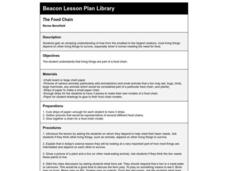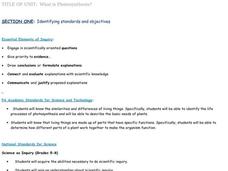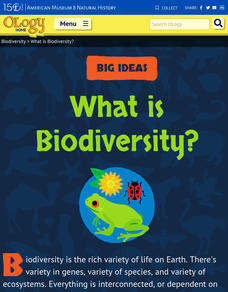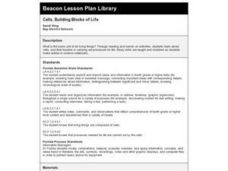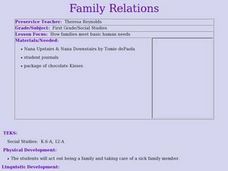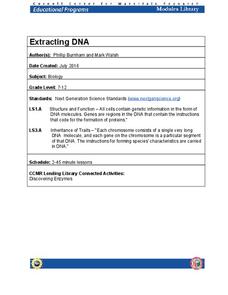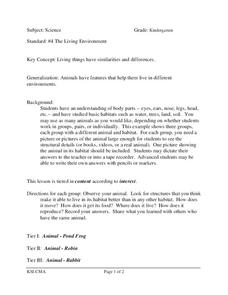Curated OER
Threatened, Endangered & Extinct Lesson Plan
Pupils examine the basic needs of living organisms. In this science lesson, students study ecosystems and discover that organisms have basic needs that must be met.
Curated OER
Outdoor Survival
Students are introduced to basic outdoor survival concepts. They identify the seven basic needs for survival. Students describe the symptoms and treatment for frostbite and hypothermia. They compare and contrast the value of different...
Curated OER
The Food Chain
First graders explore how most living things, big and small, need food for survival.
Curated OER
Creature Features
Young scholars examine why certain animals live in only specific places throughout the world. Using animals, they classify them based on their characteristics and identify their basic needs. They also observe and compare the life cycles...
Curated OER
What is Photosynthesis?
Students investigate the similarities and differences of living things. Specifically, students will be able to identify the life processes of photosynthesis and describe the basic needs of plants.
American Museum of Natural History
What is Biodiversity?
Not all dogs are the same just like not all finches are the same. An interactive online lesson helps individuals learn about the causes and limitations to biodiversity. The clickable sections describe the basics of the genetics of...
Curated OER
Fun On The Farm
Students experiment with a variety of resources to study about sounds and their sources (weather, animal, and transportation). They compare size, structure, and basic needs of living things. Each student studies about farm animals,...
Curated OER
Cells, Building Blocks of Life
Fourth graders, in groups, explore cells, the basic unit of all living things.
Curated OER
Algae Experiments
Students describe the characteristics of algae. In this biology lesson, students perform a series of experiment to explore algae. They investigate the basic things algae need to survive.
Curated OER
Predicting Plant Development
First graders investigate the basic needs of a growing plant and make predictions regarding what a seed needs in order to grow. They draw their seed predictions, listen to the book "From Seed to Plant" by Gail Gibbons, and analyze their...
Curated OER
Ecology - Biodiversity Lab
Studnents examine the degree of biodiversity that exists in one's everyday environment, in order to develop an understanding of how scientists classify organisms and to explain why biodiversity is important for living things.
Alabama Learning Exchange
Good Litter, Bad Litter
Which ones can be thrown on the ground? Discover the difference between natural litter and unhealthy trash, helping scholars by using several examples. Use the information here to give them a basic background, but also encourage prior...
Cornell University
Extracting DNA
Uncover the basics of DNA structure through exploration activities. Collaborative groups build DNA models and recreate the process of replication. Then, using plant cells such as peas or strawberries, they extract a DNA sample.
National Park Service
Reduce Our Carbon Footprint, Let’s Compost!
Roll up your sleeves and get a little dirty with this elementary and middle school compost lesson. All you need is a large plastic container, a couple old newspapers, some organic waste, and a few hundred worms and you're ready to start...
Curated OER
The Living Environment
Students investigate animals and their environments. In this animal similarities and differences lesson plan, students explore animal adaptations and features and their habitats. Students get into groups to discuss the habitat and how...
Curated OER
Pond Ecology
Fifth graders examine pond ecology, testing how temperature affects the respiration rate of fish. They collect various living things found at a pond, and identify the animal and plant life discovered. They observe a pond community in an...
Wisconsin Online Resource Center
Oversized Inch
Each member of the class creates their own paper ruler. Using their ruler, kids walk around the room measuring the objects you've specified. Discuss how items should be measured to the 16th of an inch, the smallest unit on their ruler....
Curated OER
To Dorm or Not To Dorm
For some of our students, college is right around the corner. Provide a bit of thoughtful information to help them (and their families) decide if dorm life is right for them. Included here are a list of pros and cons for living both on...
Desert Discovery
Saguaro Parts
Young biologists identify the basic structures of a saguaro cactus. They study the functions of each of the structures, and label them on a picture of a saguaro cactus embedded in the plan. This simple, and easy-to-implement lesson would...
Curated OER
How Balanced Are You?
Young learners take a look at what they eat in one day and compare it to how much physical activity they do on that same day. Point out that this is only a one-day glimpse at balancing the energy going in and what energy being used. They...
KOG Ranger Program
Match and Lighter Safety
Go over the basics of fire prevention with a lesson focused on safety with matches and lighters. With a series of dilemma cards that describe potential fire risks, learners choose the most responsible way to handle matches and lighters.
Houghton Mifflin Harcourt
American Stories: Challenge Activities (Theme 2)
For those class members who have mastered the basic concepts and need extra challenges, here's a packet of activities sure to engage them in stories about American immigration and exploration. Kids may design a dramatic presentation...
Judicial Learning Center
Law and the Rule of Law
We hear a lot about the importance of the rule of law, but most people do not really know what those words mean. The lesson is a webpage that defines the rule of law, explains why it is important in a democratic society and provides...




